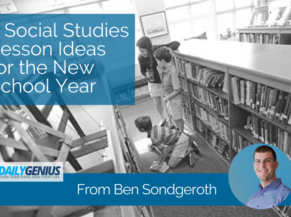This post first appeared on Daily Genius.
The start of the school year is a great time to engage your students and get them excited about the possibilities your history class might bring while encouraging them to develop their creative and critical thinking skills. When I taught high school history, I worked to create active and engaging lessons in the fall that would capture the attention of my students for the rest of the year. Here are three ideas for you to try out as the school year begins.
Tell your History Using Adobe Spark
This lesson is a great ice breaker to start the school year. The students reflect back on three events that have shaped their lives: one from their grandparents’ time, one from their parents’, and one from their own personal history. The objective is for the students to understand how events of the past have shaped who they are and how the events can affect life in the present. As my students researched, I was surprised to discover how personal their work became. I learned a lot about my students as they reflected on grandparents surviving military service, parents enduring hardships, and personal trips that ranged from the hospital to Grandma’s house every summer, that may have shaped who they had become today.
There are many tools that can be used in conjunction with this activity, but the Adobe Spark products lend themselves to an easy introductory assignment. With the ability to work as an iOS app as well as through the web-based spark.adobe.com, Spark Video allows students to import images from their selected events and record a voiceover describing the effect of that event. For an example of using Spark Video for this assignment check out my Tell your History assignment.
Analyze a Primary Source with a Visible Thinking Routine Using Google Drawing
Analyzing primary sources is an essential skill in social studies classes; however, it can be difficult for students to understand the process and what they need analyze. By implementing visible thinking routines, like the ones suggested by Project Zero, students are better able to actively process the information presented to them.
An example of this activity is presenting students with Howard Chandler Christy’s Scene at the Signing of the Constitution of the United States. The students could take the image, create a Google Drawing, identify important figures depicted in the image, and then complete a visible thinking routine designed to encourage inquiry - such as See-Think-Wonder Routine - to analyze the image. Students could use the tools within Google Drawings to draw shapes as they identify objects in the painting, and create text boxes to answer the questions of the thinking routine. For an example, view this sample Google Drawing: Signing of the US Constitution
Create a Custom Map in Google My Maps
Inside of Googlelittle-knowns a little known feature called My Maps. With My Maps, users can create custom maps that are directly integrated with their Google Drive. These maps can be created with multiple layers, allowing for vast amounts of data to be displayed on the map. Students can then share these maps with their teacher or their peers, just as they would share a Google Doc.
My Maps lessons can be incorporated into a history class in a variety of ways. One of my favorites is to create markers on a map detailing events of the Civil War, though you could choose any historical event from the start of the school year. Students could choose a battle from the war to analyze, and with a check of Wikipedia, they are able to find the latitude and longitude coordinates for that battle. Dropping those coordinates into their custom map then creates a marker, allowing them to add information about the battle, including images. This example Google My Map shows Sherman’s March to the Sea
These three activities engage students in a wide range of areas and skills by encouraging them to be critical thinkers, problem solvers, and creative in the social studies classroom setting a great tone for the start of the school year.

